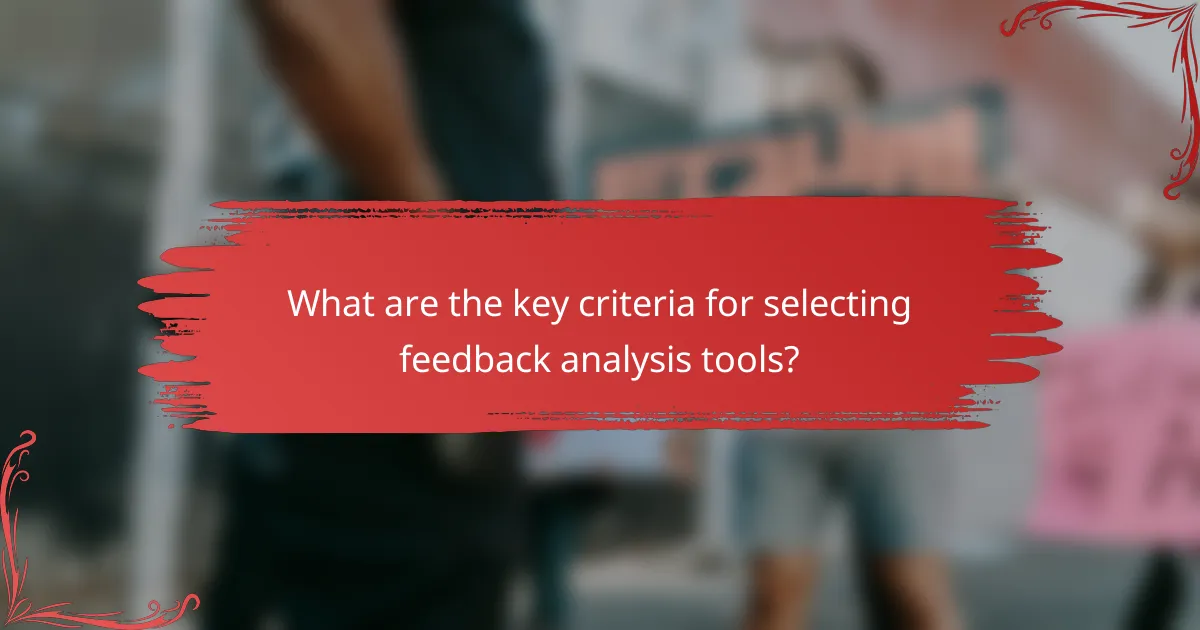Audience feedback analysis is crucial for organizations seeking to understand preferences and enhance their offerings. By employing effective techniques and utilizing specialized tools, organizations can gain valuable insights into audience sentiments and behaviors. Additionally, incorporating cultural sensitivity into the analysis process ensures that diverse backgrounds are respected, ultimately leading to more trustworthy and meaningful feedback.

What are effective techniques for audience feedback analysis?
Effective techniques for audience feedback analysis include methods that gather insights directly from the target audience, helping organizations understand preferences and improve offerings. Utilizing a combination of these techniques can provide a comprehensive view of audience sentiments and behaviors.
Surveys and questionnaires
Surveys and questionnaires are structured tools designed to collect quantitative and qualitative data from audiences. They can be distributed online or in person, allowing for flexibility in reaching diverse demographics. Aim for a mix of closed and open-ended questions to capture both specific data and detailed feedback.
When designing surveys, keep them concise to encourage participation. Aiming for 10-15 questions usually strikes a balance between depth and respondent fatigue. Consider using platforms like Google Forms or SurveyMonkey for easy distribution and analysis.
Focus groups
Focus groups involve guided discussions with a small group of participants to explore their opinions and feelings about a product or service. This qualitative method allows for in-depth insights and the opportunity to observe group dynamics and reactions. Typically, a focus group consists of 6-10 participants and lasts about 1-2 hours.
To conduct effective focus groups, prepare a set of open-ended questions and ensure a skilled moderator leads the discussion. Be mindful of cultural sensitivities and group composition to foster an inclusive environment where all voices are heard.
Social media listening
Social media listening involves monitoring online conversations to gauge audience sentiment and trends related to a brand or topic. This technique can reveal real-time feedback and emerging issues that may not surface through traditional methods. Tools like Hootsuite or Brandwatch can help track mentions and analyze sentiment across various platforms.
When engaging in social media listening, focus on specific keywords and hashtags relevant to your audience. Regularly review findings to adapt strategies and respond to audience concerns promptly, enhancing engagement and trust.
Usability testing
Usability testing assesses how easily users can navigate a product or service, providing direct feedback on user experience. This method typically involves observing participants as they complete tasks, identifying pain points and areas for improvement. Aim for a diverse group of users to gather varied perspectives.
Conduct usability tests in a controlled environment or remotely, depending on your audience. Aim for 5-10 participants per session to uncover most usability issues. Document findings and prioritize changes based on user feedback to enhance overall satisfaction.
Sentiment analysis
Sentiment analysis uses natural language processing to evaluate audience emotions expressed in text data, such as reviews or social media posts. This technique helps organizations understand overall sentiment trends and identify specific areas for improvement. Tools like Lexalytics or MonkeyLearn can automate this process.
When implementing sentiment analysis, consider the context and cultural nuances of the language used by your audience. Regularly review and refine your analysis methods to ensure accuracy and relevance, adapting to shifts in audience sentiment over time.

Which tools are best for audience feedback analysis?
Several tools excel in audience feedback analysis, each offering unique features and capabilities. The best choice depends on your specific needs, such as the type of feedback you want to gather and your budget.
Qualtrics
Qualtrics is a robust platform designed for advanced survey creation and audience feedback analysis. It offers a wide range of question types and customization options, making it suitable for complex research needs.
Consider using Qualtrics if you require detailed analytics and reporting features. Its ability to integrate with other software can streamline data collection and analysis, but it may come with a higher price tag compared to simpler tools.
SurveyMonkey
SurveyMonkey is a user-friendly tool that allows you to create surveys quickly and gather audience feedback efficiently. It offers various templates and question types, making it accessible for users with varying levels of expertise.
This platform is ideal for small to medium-sized businesses looking for cost-effective solutions. While it provides essential analytics, more advanced features may require a paid plan.
Google Forms
Google Forms is a free tool that enables users to create surveys and collect audience feedback easily. Its integration with Google Sheets allows for straightforward data analysis and sharing.
While it may lack some advanced features found in paid tools, Google Forms is perfect for simple surveys and quick feedback collection. It’s particularly useful for teams already using Google Workspace.
Hootsuite
Hootsuite primarily serves as a social media management platform but also offers audience feedback analysis through social listening tools. It helps track audience sentiment and engagement across various social media channels.
Utilize Hootsuite if your focus is on social media feedback. Its analytics can provide insights into audience reactions and trends, though it may not be as comprehensive for traditional survey methods.
Tableau
Tableau is a powerful data visualization tool that can analyze audience feedback data effectively. It allows users to create interactive dashboards and visual reports, making complex data easier to understand.
Consider Tableau if you have large datasets and need to present findings visually. While it requires some technical expertise, its capabilities in data analysis can significantly enhance your feedback insights.

How to ensure cultural sensitivity in feedback analysis?
Ensuring cultural sensitivity in feedback analysis involves recognizing and respecting the diverse backgrounds of respondents. This approach enhances the quality of insights gathered and fosters trust within various communities.
Understanding cultural contexts
Cultural contexts shape how individuals perceive and respond to feedback requests. Factors such as traditions, values, and social norms can significantly influence feedback interpretation. For instance, in some cultures, direct criticism may be viewed as disrespectful, while in others, it may be expected.
To effectively analyze feedback, it’s crucial to research and understand these cultural nuances. Engaging with local experts or conducting preliminary surveys can provide valuable insights into the specific cultural dynamics at play.
Inclusive language use
Using inclusive language is essential for making all respondents feel valued and understood. Avoid jargon or idioms that may not translate well across cultures. Instead, opt for clear and straightforward language that resonates with a diverse audience.
For example, instead of saying “hit the ground running,” you might say “start immediately.” This small change can make a significant difference in how feedback is received and interpreted.
Adapting feedback methods
Different cultures may prefer various feedback methods, such as surveys, interviews, or focus groups. Adapting your approach to align with local preferences can enhance participation and the quality of responses. For instance, some cultures may favor face-to-face interactions over digital surveys.
Consider using a mix of qualitative and quantitative methods to capture a broader range of insights. This can include open-ended questions that allow for personal expression alongside structured rating scales.
Engaging local communities
Engaging local communities is vital for gathering culturally sensitive feedback. Building relationships with community leaders can facilitate trust and encourage participation in feedback initiatives. This collaboration can also provide deeper insights into cultural values and expectations.
Hosting community forums or workshops can be an effective way to gather feedback while fostering a sense of ownership among participants. Ensure that these events are accessible and respectful of local customs to maximize engagement.

What are the key criteria for selecting feedback analysis tools?
Key criteria for selecting feedback analysis tools include cost-effectiveness, user-friendliness, integration capabilities, and data security features. Evaluating these aspects ensures that the chosen tool meets organizational needs while providing valuable insights into audience feedback.
Cost-effectiveness
Cost-effectiveness is crucial when selecting feedback analysis tools, as it directly impacts your budget. Consider tools that offer a balance between features and price, often ranging from free basic versions to subscription models costing hundreds of USD per month.
Look for tools that provide a clear return on investment (ROI) by improving decision-making and enhancing customer satisfaction. Free trials can help assess value before committing financially.
User-friendliness
User-friendliness is essential for ensuring that team members can effectively utilize the feedback analysis tool. A straightforward interface and intuitive navigation can significantly reduce the learning curve and increase adoption rates.
Evaluate tools that offer comprehensive tutorials, customer support, and community forums. Tools with drag-and-drop functionalities or visual dashboards can enhance usability and facilitate quicker insights.
Integration capabilities
Integration capabilities determine how well a feedback analysis tool can work with your existing systems, such as CRM or marketing platforms. Tools that seamlessly integrate can streamline workflows and enhance data accuracy.
Check for compatibility with popular software solutions and APIs that allow for custom integrations. A tool that can consolidate data from multiple sources will provide a more comprehensive view of audience feedback.
Data security features
Data security features are vital to protect sensitive audience information and comply with regulations such as GDPR. Ensure that the feedback analysis tool employs encryption, secure access controls, and regular security audits.
Look for tools that provide transparency regarding their data handling practices and have certifications or compliance with recognized standards. Regular updates and support for data privacy are also important considerations.
